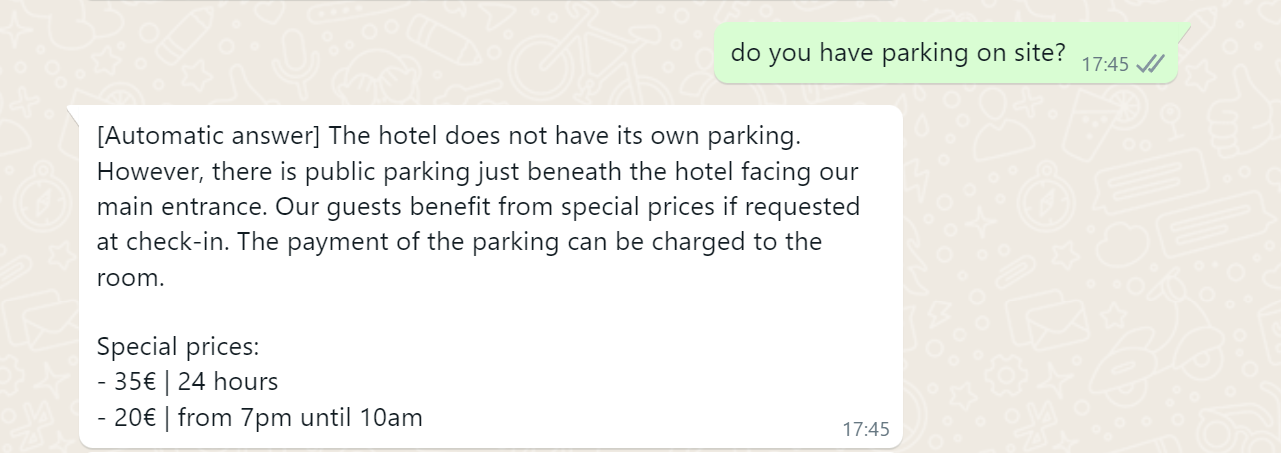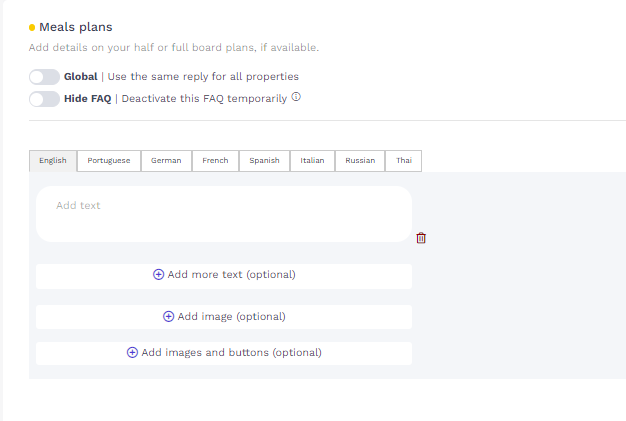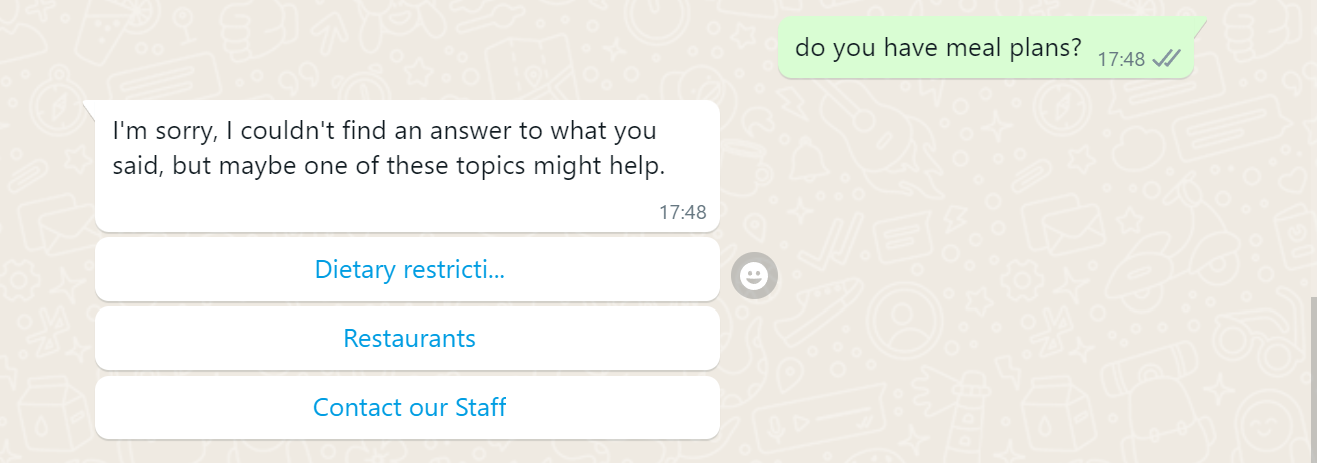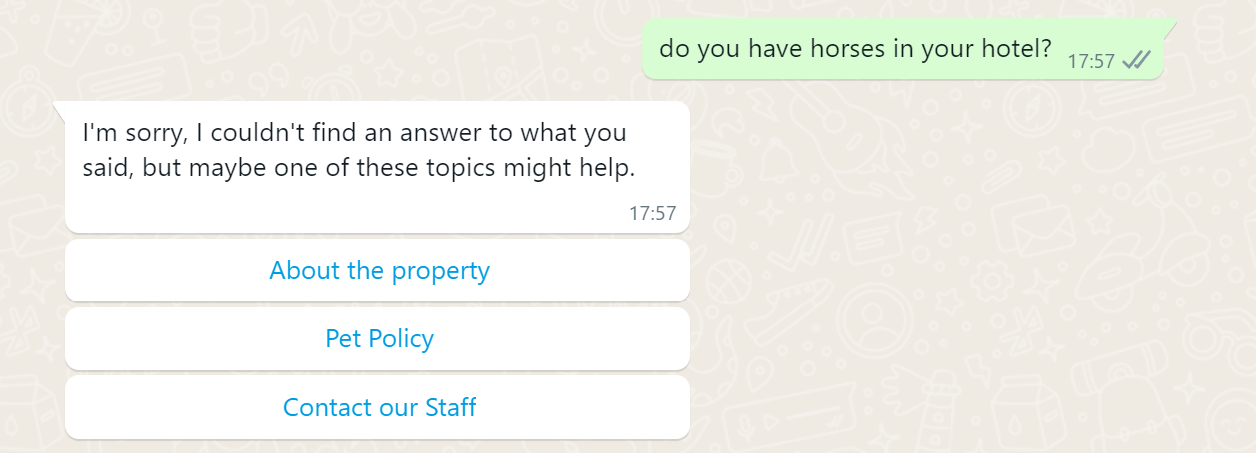In-Stay Chatbot
Understand how our in-stay chatbot works
Our In-Stay Chatbot is connected to a WhatsApp Business number and covers your guests' journey from before arrival to post departure.
This chatbot works as a two-way communication tool:
- It allows you to send whatsapp messages (campaigns) automatically to your guests - by receiving daily information from your PMS
- Guests can ask questions about the property or their stay on WhatsApp and automatic replies will be provided to them. If needed, the conversation will be transferred to the console to be handled by a human agent.
How does it work?
The hotel guests will have access to the hotel's WhatsApp number in 2 ways:
- The hotel provides the hotel WhatsApp number to the guests (for example: A QR code in the confirmation page or in the hotel rooms and public areas)
- The hotel sends a WhatsApp campaign automatically to its guests according to the dates of check-in, check out and reservation status. Once the guest receives it, the channel is open to communicate
There are 5 major parts to the in-stay chatbot:
WhatsApp Campaigns:
As a two-way communication solution, the in-stay chatbot allows hotels to send whatsapp campaigns to your guests.
These campaigns have to be pre-approved by META and, once approved, will be sent automatically to your guests, according with the information that we have received from your PMS.
See an example of a WhatsApp Campaign below:

Intent detection and learning
Whenever the guest sends a written message, the chatbot will try to identify what the user is inquiring about by matching it to one of the topics or flows the chatbot was taught beforehand, based on the topics filled in by you in the console (Chatbots Menu).
After it detects the user's intent, the chatbot will then attribute a score on how confident it is that the intent detected is the correct one. The higher the score, the more chances of it being correct. Usually, 70% or above is a very good confidence score.
After processing the users' query, there are the following possible outcomes:
- If it detects an intent with a confidence score equal or superior to the pre-defined threshold (by default 70%), the chatbot returns an automatic answer (if the answer exists) or begins a flow;

- If it detects an intent with a confidence score equal or superior to the pre-defined threshold (by default 70%), but there isn't an answer or flow for that intent, the will suggest alternative topics related to the topic asked;


- If it detects an intent with a confidence score equal or superior to the pre-defined threshold (by default 70%), but already gave the answer to that intent the moment before, the chatbot sends the conversation to the staff - see more about duplicate intents;


- If it detects a topic with confidence between 40% and 70%, it asks the user if the topic being asked about is really that one or a similar one, and then the user can select one of those topics or select to speak with the staff - see more about similar intents;

- If it doesn't detect any intent or the intent it detected is below 40%, it automatically sends the conversation to a human agent.


Whenever the chatbot does not understand a query, that is, does not detect an intent with a good enough confidence score (>70%), that sentence will be added to HiJiffy's query pool. We kindly ask you to report these messages in the console to be analyzed and taught to the chatbot. With time, more intents and more queries are added to the chatbot and it will get smarter, understanding more phrases and word combinations in each intent.
How to report a sentence in the console?
Automated responses
Automated responses are all the responses the chatbot has pre-configured to return to the user when it detects a certain intent or after a certain action taken on the decision tree, such as the user selecting a button.
An automated response can consist of text and buttons for the in-stay chatbot. The majority of automated responses in a chatbot will usually be the ones created to reply to FAQs. You can see more about how to edit your Automatic replies to FAQs in here.
Flows
A flow in the chatbot consists of a sequence of predefined steps with the goal of collecting information from the user. Each step consists of a question that requires guest input (whether by typing or selecting an option) to move to the next question.
At the end of the flow, a request will be generated in the Console for your team to manage. For more information regarding Requests, please check this guide.
To learn about all existing flows in the in-stay solution, click here.
Human handoff
Whenever the chatbot is unable to help the user (following the scenarios outlined above) or the guest explicitly requests to talk to someone (by selecting to chat with staff from the options given or by asking for it), the chatbot will transfer the conversation to the HiJiffy console for a human agent to handle.